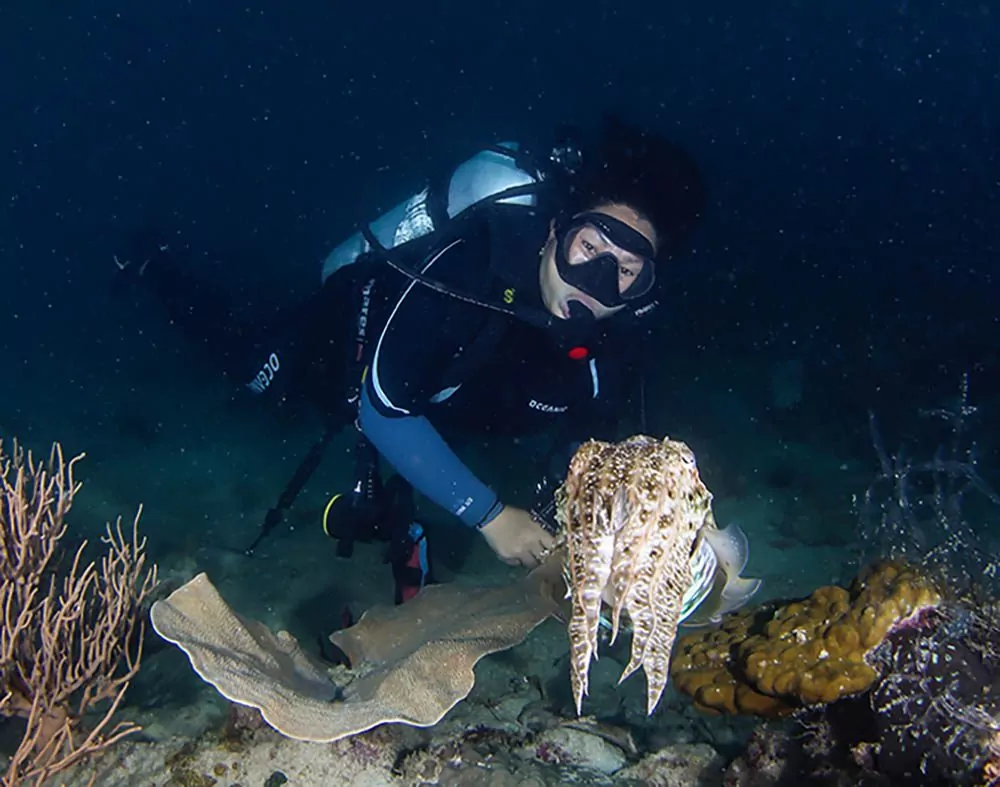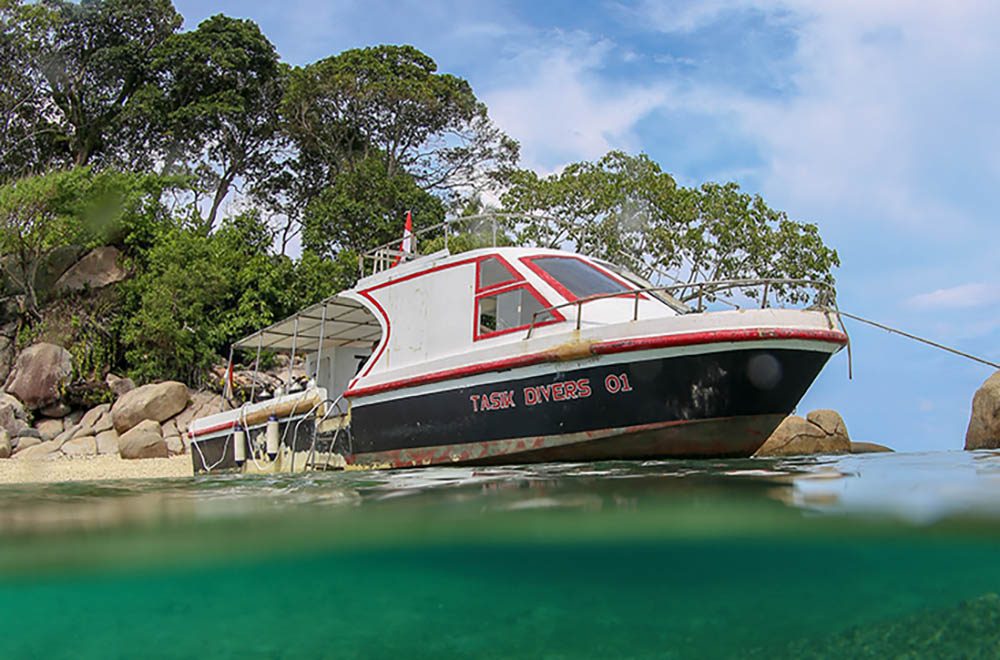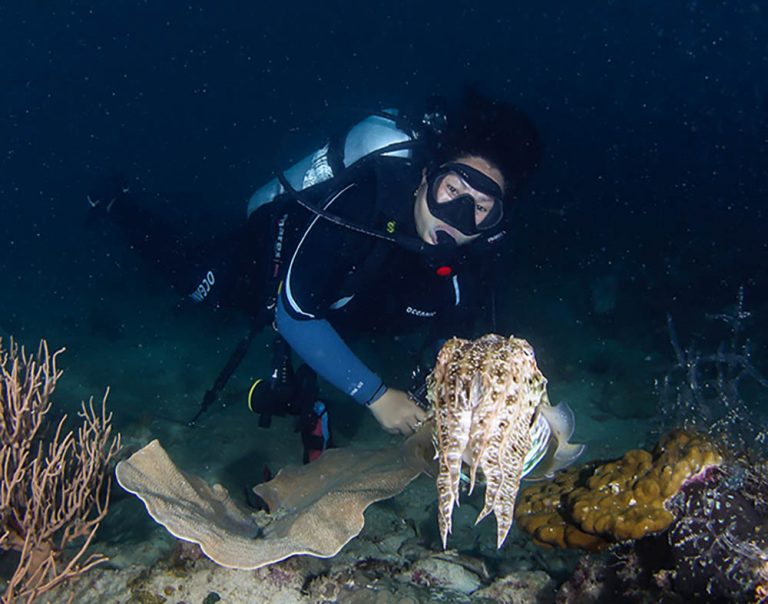INDONESIA DIVER
Stopover in Bintan
A few days to spare…what to do? LISA COLLINS went to explore the little-known island to which Singaporeans like to escape when they have time off. But would the diving pass muster?

Monica with a large cuttlefish at Umbrella Point.
WE WERE TRAVELLING to Indonesia via Singapore as part of a bigger trip on a liveaboard, but wanted to arrive before Mateusz’s big birthday, to get over jet lag and celebrate somewhere exotic. We normally fly with Singapore Airlines via Singapore, preferring to stay overnight before continuing our journey to Indonesia.
This time, however, because of the timing of the start of the liveaboard trip and the birthday, we had five nights to spare.
Having been to Singapore several times in the past, we decided not to stay there, but to try to find somewhere neither of us had visited before – somewhere that could also double up as a place to do a few easy dives before going onto the liveaboard.
I had heard about Bintan Island many years ago, and had been curious to visit, so it sprang to mind as a possible destination for a few days.
Located only an hour’s fast ferry-ride from Tanah Mera Ferry Terminal, close to Singapore’s Changi Airport, Bintan is one of the Rui Islands and actually part of Indonesia. It might be close to Singapore, but it felt a world away.
Most of the tourist hotels were located in the North at Lagoi, where there is a purpose-built area with several golf courses and 15-plus high-end hotels offering a host of tourist sports and activities.
The area is separated from the rest of the island by a customs checkpoint.
Indonesia, hot on the importation of excessive duty-free, is a little more lenient in this tourist area, which is designed to allow high-earning Singaporeans to escape the city for the weekend.
A couple of dive-centres are located among these hotels, catering for try-dives and courses, but they also offer day-trips to the south-eastern part of the island, where the best diving is found.
I had thought to stay in one of the northern hotels for ease and a quick transfer, but quickly discounted them after finding a small, peaceful resort next to access to Bintan’s best diving – Trikora Beach Club.
The 8.10am ferry was full of overnighters, golfers and competitors visiting to practise for the Bintan Ironman competition, due to be held in a couple of weeks’ time.
A group on an incentive drive for a Singaporean company told us it was their first visit to Bintan Island and also their first to Indonesia, despite it being so close.
Another lady saw our dive-bags and asked if there was diving in Bintan.
A diver herself, she had been to the island several times before but had never realised that good diving could be had.
Bintan Island is roughly the size of the Isle of Wight, and the crossing reminded me of that ferry journey from England’s south coast.
We took a 55-minute taxi-ride to Trikora, bypassing the tourist area, and seemed to be going back in time. The very good road took us through the middle of the island, past small farms, tiny villages and wooden shacks dotted here and there, surrounded by dense foliage and coconut trees growing in a bright reddish-orange soil. The soil is rich in bauxite, which is mined for aluminium.
We passed only a few other cars and motorbikes. The journey was such a stark contrast to the Singaporean hustle.
Appeared in DIVER December 2018
AT THE SEA WE TURNED RIGHT, following the shoreline for another 10 minutes and passing many floating homes in the bay, amid small green islands surrounded by sparkling golden beaches. The Rui Islands are famous for their communities of sea-gypsies, people who live off the ocean.
The hotel is small, with 20 garden- and ocean-view villas, infinity pool and barefoot restaurant. It overlooked a white-sand beach and the South China Sea.
I had arranged scuba-diving some months before with Tasik Divers,
Bintan, sister of the well-known Manado operation. Originally located beside Trikora, the company had recently bought in a co-owner, changed the name to Dive In Bintan and moved half a mile away to near Agro Beach.
Monica Udap had moved from Manado to manage the dive centre, as had El, our dive guide and Cristian, one of the boat crew. They came from Dive In Bintan to our hotel to discuss our diving that afternoon.
For variety, and because of the tides and currents, it was decided to do two macro dives the following afternoon, and two wide-angle dives the next day.
Guiltily pleased that we didn’t have to get up early the next morning, we enjoyed an early lunch prepared by the excellent chef at Trikora before our pick-up.
The dive-boat met us with all our gear and cameras on board at the end of the 150m jetty, and took us to picturesque White Island, around 15 minutes away.
El’s briefing described a mini wall with a wide sand bottom to a depth of a maximum of 15m. Most of the diving around Bintan is between 8 and 15m, handy for long shallow dives and for those with restricted depths.
Deeper dives are available on the wall on the outside of the reef surrounding the islands, but the weather and sea conditions needed to be more favourable to get us beyond the reef.

Only around 40m from the beach, there appeared to be no current, but as soon as we hit the bottom at 10m we felt a strong flow. After a few minutes spent fighting it, Monica signalled us to abort the dive.
Monica explained that both the currents and the tides could be unpredictable, making it difficult to predetermine the dive-sites, but that there were plenty of protected sites.
We tried again on the other side of the island. With no current, we spent just over an hour gently mooching around, finding a surprising number of critters on the white sandy bottom.
El and Monica delighted in pointing out numerous varieties of nudibranch, tiny flatworms and Pederson and anemone shrimps hiding in different types of anemones. Several large anemones showed purple or white mantles, with families of dancing anemonefish posing for us.
A white devil scorpionfish looked at me evilly and charged threateningly as I got close. I had been moving in to take a photograph of a beautiful Flabellina nudibranch, with bright pink filaments swaying in the water, and the scorpionfish took me by surprise, well-camouflaged as it was next to the nudibranch. Mateusz likes finding tiny filefish, and spotted many hiding among Halameda algae, including whitebar, bristle-tailed and minute varieties.
Many different gobies shared a burrow with shrimps on the sandy bottom, scattered among colourful shells.
A huge Spanish dancer nudibranch flapped elegantly past before settling on the bottom.
VISIBILITY WAS ONLY AROUND 8-10m, so we moved slowly over the sandy bottom, keeping within bubble-sight of each other. With only the four of us diving, we went at our own easy pace.
Most of Dive In Bintan’s clients are Singaporeans and expats who come to the island for a few days on the early-morning ferry, doing two to four dives a day and returning on the evening ferry.
It was April, still early in the season. The dive-centre closes from November to the end of March when conditions can be rough, and the busiest season is from May to August.
Towards the end of the dive we reached a mini wall. I was delighted by the quantity and variety of hard corals, interspersed with seafans, whip and other soft corals and sponges. They all looked healthy, with no sign of coral-bleaching, despite the water temperature being a balmy 31°.
During our surface interval we were plied with a second delicious and unexpected lunch. We had expected fresh fruit and biscuits on the boat but Monica said that the dive-centre always provided a proper meal as part of the price of the diving, regardless of what time you dived.
We continued diving where we had left off, and could have spent hours happily exploring both the sandy bottom and the mini-wall.
At the bottom, however, the current picked up again, though it wasn’t as strong as on our aborted dive. We hugged the sandy bottom now, looking for critters, rather than the wall.
El spotted a long-legged spider-crab, while Mateusz pointed out a blue-legged crab hiding among some algae and a large crab burrowed beneath a log.
We also saw a large, crazily patterned map pufferfish resting on the reef, and one I had never seen before, an immaculate puffer, with its smooth greenish-white body.
Indonesia has a particular problem with plastic oceans, partly because of the three different currents that run through the hundreds of islands that make up the nation, bringing rubbish from faraway countries, and partly because of the poor waste-disposal services found in many Asian countries.
I was very happy to see only one piece of trash on all our dives, a black plastic bag that Monica immediately picked up.
As the tide had come in at the end of our dive, the dive-boat happily dropped us back at Trikora beach – more time for relaxation and an early cocktail hour.
The next day our dives were delayed until 12.30 for a high tide that was slow coming in. The sun was shining as the boat arrived, but there were ominous clouds over the island.
AS WE PUSHED AWAY from the beach, we saw several lightning bolts. Because of the minerals in the soil, lightning here can be very powerful, and we hoped it wouldn’t progress out to where we would be diving.
Conditions weren’t good enough for diving the outer wall, so Monica took us to a small island with a coconut tree on top, called Umbrella Point. El described a small sloping wall with a sandy bottom at 15m.
Visibility was better than the previous day, at around 12-15m, and with very little current. On the reef slope we could see many colourful bright purple ball anemones with lots of anemonefish.
We spent some time photographing them, carefully avoiding the many black spiny sea urchins prevalent at all the dive-sites.
Moving on from a particularly large congregation of purple anemones, El spotted a large pinnate spadefish. It turned to show us one blinded eye and posed patiently.

I was watching a tiny moray eel hiding in a hole at the bottom of the reef when Monica called us over to indicate a large, well-camouflaged, cuttlefish in a depression in the reef.
Again, the many varieties of hard and soft coral, sponges and seafans created a colourful scene. There were no big fish or pelagics but plenty of small fish, including some I didn’t recognise.
Between dives, the boat captain moored at a tiny deserted island, its white-sand beach full of shells and surrounded by large boulders.
The clouds had cleared somewhat by the time we ascended, and we spent our safety stop, after a nasi goreng lunch. cooling ourselves in the sunny shallows.
Another tiny island, Kojeck Point, was named after the boat captain. El said that most of the dive-sites in the area were a combination of mini-wall, sloping wall and sandy bottom.
We cruised slowly along the edge of the reef where it met the bottom at 13m, investigating nooks and crannies and delighting in the many anemonefish, giant clams and schools of glassfish, butterflyfish and soapfish.
Towards the end of the dive, Mateusz spotted a large sailfin butterflyfish. As I waited for him to take a photo, a group of razorfish swam past in formation.
THE DIVING IN BINTAN had surprised me, and in a good way. My pre-visit researches had revealed few underwater photos of the scuba-diving, and none that were any good.
As we motored back to the dive-centre we passed one of the sea-gypsy floating homes/fishing platforms, much larger than expected when seen up close.
Their owners manoeuvre them around the islands and also join them together to create “villages” at times. Not such a bad life.
Freed, Monica’s brother, took us for a small tour of the southern part of the island. He wanted us to see an area called the Blue Lakes before the sun set.
The disused bauxite and glass mineral quarry had gradually filled with water to a depth of 30m and was a spectacular shade of blue. At sunset, when we arrived, the colours were vivid against the white glass minerals and bright orange bauxite.
Dinner in Rimba Jaya, where a covered market is home to street-food kitchens catering for all tastes, was the perfect ending to our immersion at Bintan Island.
FACTFILE
GETTING THERE> Fly to Singapore from major UK airports with Singapore Airlines or other companies. Take a ferry from Singapore Tanah Merah Ferry Port with BRF Ferries, brf.com.sg. There are five to seven departures a day each way.
 DIVING> Dive in Bintan, bintandivers.com
DIVING> Dive in Bintan, bintandivers.com
ACCOMMODATION> Trikora Beach Club, but there are other options close by or more expensive, resort-type accommodation at Lanoi, trikorabeachclub.com
WHEN TO GO> April to October. Air and water temperatures year round are 28-32°C. The rainy season is November to March.
MONEY> Indonesian rupiah.
PRICES> Flights from around £500 return. Ferry £35 return. Trikora costs around £80pp per night. Two-tank boat-dives including pick-up/drop-off from the Trikora area with lunch cost £60. For the same package but with pick-up/drop-off from the Lanoi area, the price is £100.
VISITOR Information> indonesia.travel

